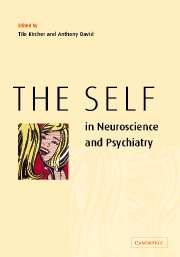Book contents
- Frontmatter
- Contents
- List of contributors
- Introduction: the self and neuroscience
- Part I Conceptual background
- Part II Cognitive and neurosciences
- 5 The multiplicity of consciousness and the emergence of the self
- 6 Asynchrony, implicational meaning and the experience of self in schizophrenia
- 7 Self-awareness, social intelligence and schizophrenia
- 8 The neural correlates of self-awareness and self-recognition
- 9 Autonoetic consciousness
- 10 The neural nature of the core SELF: implications for understanding schizophrenia
- Part III Disturbances of the self: the case of schizophrenia
- 11 Self and schizophrenia: a phenomenological perspective
- 12 Self-disturbance in schizophrenia: hyperreflexivity and diminished self-affection
- 13 The self-experience of schizophrenics
- 14 The paranoid self
- 15 Schizophrenia and the narrative self
- 16 Self-narrative in schizophrenia
- 17 Schizophrenia as disturbance of the self-construct
- 18 Action recognition in normal and schizophrenic subjects
- 19 Disorders of self-monitoring and the symptoms of schizophrenia
- 20 Hearing voices or hearing the self in disguise? Revealing the neural correlates of auditory hallucinations in schizophrenia
- 21 The cognitive neuroscience of agency in schizophrenia
- 22 Self-consciousness: an integrative approach from philosophy, psychopathology and the neurosciences
- References
13 - The self-experience of schizophrenics
from Part III - Disturbances of the self: the case of schizophrenia
Published online by Cambridge University Press: 18 December 2009
- Frontmatter
- Contents
- List of contributors
- Introduction: the self and neuroscience
- Part I Conceptual background
- Part II Cognitive and neurosciences
- 5 The multiplicity of consciousness and the emergence of the self
- 6 Asynchrony, implicational meaning and the experience of self in schizophrenia
- 7 Self-awareness, social intelligence and schizophrenia
- 8 The neural correlates of self-awareness and self-recognition
- 9 Autonoetic consciousness
- 10 The neural nature of the core SELF: implications for understanding schizophrenia
- Part III Disturbances of the self: the case of schizophrenia
- 11 Self and schizophrenia: a phenomenological perspective
- 12 Self-disturbance in schizophrenia: hyperreflexivity and diminished self-affection
- 13 The self-experience of schizophrenics
- 14 The paranoid self
- 15 Schizophrenia and the narrative self
- 16 Self-narrative in schizophrenia
- 17 Schizophrenia as disturbance of the self-construct
- 18 Action recognition in normal and schizophrenic subjects
- 19 Disorders of self-monitoring and the symptoms of schizophrenia
- 20 Hearing voices or hearing the self in disguise? Revealing the neural correlates of auditory hallucinations in schizophrenia
- 21 The cognitive neuroscience of agency in schizophrenia
- 22 Self-consciousness: an integrative approach from philosophy, psychopathology and the neurosciences
- References
Summary
Abstract
A severe disorder of the self-experience is conceived as the common experiential denominator of the heterogeneous group of schizophrenic psychoses. The ego-pathology focuses on this ego-disorder in its five basic dimensions (vitality, activity, consistency/coherence, demarcation, and identity).
A population of 664 probands (552 schizophrenics, 25 borderline personality disorder, 87 depressive disorder, Diagnostic and Statistical Manual of Mental Disorders (DSM-III-R) American Psychiatric Association, 1987) was systematically studied using the Ego Pathology Inventory (53 items). The most important evaluation was the confirmatory factor analysis.
The self-experience of schizophrenics concerns the uncertainties, deficits or even annihilation of the five basic dimensions. Confirmatory factor analysis allows comparison between theoretical and empirical item allocation and shows a high congruence (kappa 0.95). Analysis of variance between the three diagnostic groups on the level of items as well as scales shows differences in the respective proband groups. External measurements serve as arguments for the validity of the model.
The concept of five basic dimensions of self-experience can be shown as a reliable, valid and viable approach to study empirically the disordered ego/self of schizophrenics and other diagnostic groups. Concerning therapeutic consequences, some hints for a need-adapted treatment are given with the aim of reconstructing the disordered self-experience, even in body awareness.
A detailed presentation of the psychopathology research reported in this article is published in Scharfetter (1996). The first article was published in English in 1981.
- Type
- Chapter
- Information
- The Self in Neuroscience and Psychiatry , pp. 272 - 290Publisher: Cambridge University PressPrint publication year: 2003
References
- 12
- Cited by



